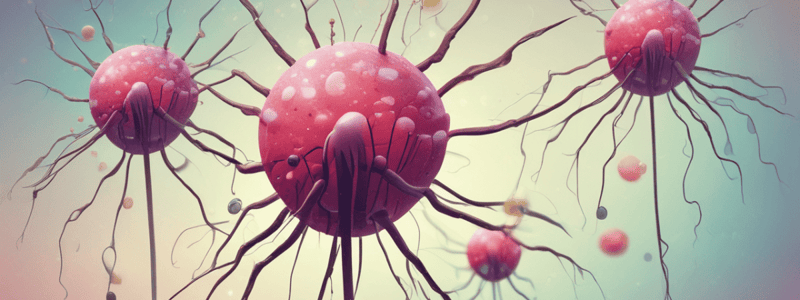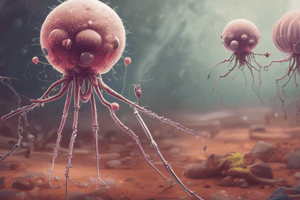Podcast
Questions and Answers
What is a drawback of traditional antibiotics in combating pathogenic microorganisms?
What is a drawback of traditional antibiotics in combating pathogenic microorganisms?
Resistance to antibiotics is not limited to targeted bacteria, and it can take several years to develop new antibiotics.
What mechanism do bacteria use to protect their own DNA from restriction endonucleases?
What mechanism do bacteria use to protect their own DNA from restriction endonucleases?
Modifications such as methylation.
What is the primary application of CRISPR technology?
What is the primary application of CRISPR technology?
Gene editing.
How do phages play a role in the development of CRISPR technology?
How do phages play a role in the development of CRISPR technology?
What is a key difference between traditional antibiotics and phage therapy?
What is a key difference between traditional antibiotics and phage therapy?
What is the primary function of the plaque assay in bacteriophage analysis?
What is the primary function of the plaque assay in bacteriophage analysis?
How do temperate phages differ from lytic phages in terms of their replication cycles?
How do temperate phages differ from lytic phages in terms of their replication cycles?
what forms the prophage and in what cycle?
what forms the prophage and in what cycle?
What determines whether a bacteriophage will undergo a lytic or lysogenic cycle?
What determines whether a bacteriophage will undergo a lytic or lysogenic cycle?
What is the structural characteristic of icosahedral bacteriophages?
What is the structural characteristic of icosahedral bacteriophages?
During the lytic cycle, what is the function of the enzymes that break the cell's peptidoglycan, leading to osmotic lysis?
During the lytic cycle, what is the function of the enzymes that break the cell's peptidoglycan, leading to osmotic lysis?
How do the C1 and cro proteins compete with each other in the operator region of the phage genome?
How do the C1 and cro proteins compete with each other in the operator region of the phage genome?
What is the role of CII protein in phage development, and how is it regulated?
What is the role of CII protein in phage development, and how is it regulated?
How does the phage switch between lysogenic and lytic cycles in response to host cell conditions?
How does the phage switch between lysogenic and lytic cycles in response to host cell conditions?
What is the significance of lysogenic conversion, and how does it contribute to antibiotic resistance?
What is the significance of lysogenic conversion, and how does it contribute to antibiotic resistance?
What are the four principles of phage therapy, and why are they important?
What are the four principles of phage therapy, and why are they important?
How do bacteriophages differ from antibiotics in their mode of action, and what are the implications for their use in treating infections?
How do bacteriophages differ from antibiotics in their mode of action, and what are the implications for their use in treating infections?
Flashcards are hidden until you start studying
Study Notes
Bacteriophage Cycles
- C1 facilitates the synthesis of genes needed for lysogenic cycle, while Cro facilitates the synthesis of genes needed for lytic cycle.
- The region between C1 and Cro is operator sequences, which they interact with and physically compete for.
- More C1 binding to the operator region means it will outcompete Cro and undergo lysogenic cycle, and vice versa.
Phage Switching Mechanism
- CII is a protein involved in monitoring the health of the cell and decides which cycle to choose accordingly.
- CII is sensitive to degradation by host proteases, specifically HfLA.
- When cells are actively growing and have enough nutrients, they produce high levels of HfLA, degrading CII, leading to lytic growth.
- When cells have limited nutrients, they produce less HfLA, allowing CII to activate and promote lysogenic growth.
Lysogenic Conversion and Phage Therapy
- Lysogenic bacteriophages can contribute to the development of antibiotic resistance.
- Phage therapy uses lytic bacteriophages to treat pathogenic infections, with four principles:
- Phage must be lytic.
- A single dose of phage should treat infection.
- Phage is non-toxic and highly specific for targeted bacterial populations.
- Antibiotic-resistant bacteria remain sensitive to phage-mediated lysis.
Bacteriophages Characteristics
- Bacteriophages usually target a very narrow host range, requiring the disease-causing bacterium to be identified.
- They have different shapes, genetic composition (single or double-stranded, RNA or DNA), and genome size (4 to 100s of genes).
Phage Analysis and Isolation
- Plaque assay is used to analyze and isolate phages, involving:
- Sample collection from the environment.
- Sample dilution.
- Mixing with appropriate host cells.
- Pouring on agar plate.
- Incubation to allow growth.
- Plaque formation, creating a clear zone in the bacterial lawn.
Bacteriophage Structure and Types
- Structure can be icosahedral or filamentous.
- There are two types of bacteriophages:
- Lytic phages, which can only undergo lytic cycles.
- Temperate phages, which can undergo lytic and lysogenic cycles.
Lytic and Lysogenic Cycles
- Lytic cycle:
- Adsorption/attachment.
- Penetration.
- Replication and synthesis.
- Assembly.
- Release.
- Lysogenic cycle:
- Attachment/adsorption.
- Penetration.
- Prophage formation.
- Maintenance.
- Spontaneous induction.
- Replication and synthesis.
- Assembly.
- Release.
Phage Defense Mechanisms
- Bacteria possess different ways to fight against viral attacks, including:
- Restriction endonucleases, which recognize short and specific sequences and cut them.
- CRISPR (clustered regularly interspaced short palindromic repeats), a system that protects hosts' own DNA by modifications such as methylation, and has applications in gene editing.
Studying That Suits You
Use AI to generate personalized quizzes and flashcards to suit your learning preferences.




